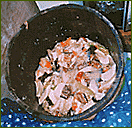|

1) A comparison of the chief nutrients in raw herrings and
migakinishin (dried herrings that have
had their heads and tails removed and have been cut in half)
Winter is the best time of the year to make Nishinzuke because
it's the best season for catching herrings.
Locations in the north, such as Hokkaido, are best for catching
herrings.
There are many types of herrings such as raw herrings, smoked herrings
and the migakinishin that we use
to make pickled herrings. I would like to compare the chief nutrients in
raw herrings and migakinishin.
|
raw herring
( per 100 g )
|
migakinishin
( per 100 g )
|
| protein |
16.0 g
|
29.2 g
|
| calcium |
100 mg
|
190 mg
|
| iron |
1.1g
|
2.1g
|
You can see that migakinishin are higher in
nutrients than raw herrings. Thus, pickled
herrings made from migakinishin contain many nutrients and are
very good for your health.


My grandmother Umeko's special
recipe
Ås Quantity .... at any one time, my grandmother makes enough pickles to
fill a barrel (30Å~30cm) that she keeps
at her house Åt
|
Ingredients
|
| Japanese
radish |
1/2
|
| migakinishin |
1
|
| cabbage |
1/4
|
| carrot |
1/4
|
| kombu |
a little
|
| ginger |
a little
|
| kouji |
a little
|
| salt |
to taste
|
* It's OK to use leftovers.

1. Cut a Japanese radish that has been dried for 4-5 days into bite-size
pieces.
2. After letting the dried herring stand overnight in either water
that has been used to wash rice or nuka,
wash it and cut it into bite-size pieces.
3. Cut up the cabbage and carrot.
4. Mix the kouji, kombu, dried herring, carrot and
ginger, and sprinkle with salt.
5. Mix in the cabbage and Japanese radish.
6. Place a weight (stone) on top of the container.
7. After 2-3 days have passed then the pickles are ready to
eat.

|


